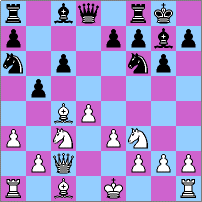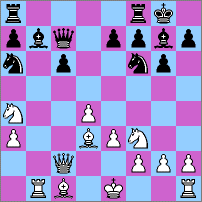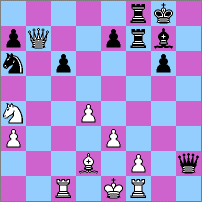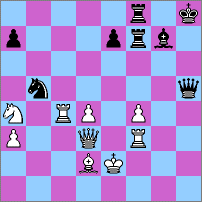Emanuel Lasker - Carl Schlechter
Queen's Gambit Declined, Slav Defence [D94]
Berlin, game 10, 19101.d4 d5 2.c4 c6 3.Nf3 Nf6 4.e3 g6 5.Nc3 Bg7 6.Bd3 0-0 7.Qc2 Na6 8.a3 dxc4
9.Bxc4 b5Lasker switched to 1.d4 for this game, having had little success with 1.e4 earlier in the match. He must have been feeling well satisfied with his choice of opening around here since Black now depends on active counterplay to compensate him for the weakeness of his c-pawn. If Schlechter had been more inclined to hold tight for the draw, he probably would not have played his eigth move, but would have kept his d-pawn where it was.
10.Bd3 b4 11.Na4 bxa3 12.bxa3 Bb7 13.Rb1 Qc7
Now White could try to play positionally with 14.0-0, intending 15.Bd2 and 16.Rfc1 with pressure against c6 and control over the c5 square. Black would have countered this with 14...Nd7, aimingfor the freeing move ...c5. Instead, Lasker starts to play on the kingside.
14.Ne5 Nh5
14...Nd7 would have failed tactically to 15.Rxb7 Qxb7 16.Bxa6.15.g4
Lasker needed to win this game and plays without compromise. Going for material with 15.Bxa6 Bxa6 16.Qxc6 Bxe5 17.Qxa6 was possible but not appealing. Under less critical circumstances, I suspect Lasker might have played 15.f4 with a pleasant position. Now the game gets very sharp.
15...Bxe5 16.gxh5 Bg7 17.hxg6 hxg6 18.Qc4
Threatening both Bxg6 and Rxb7.
18...Bc8! 19.Rg1
Still playing for the initiative (sometimes defined as 'the ability to create threats') rather than for material. After 19.Bxg6 Be6 20.Bxf7 Bxf7 21.Qxa6 Bd5 Black would have got compensation, especially with the e7-e5 break to come.
19...Qa5+ 20.Bd2 Qd5 21.Rc1 Bb7 22.Qc2 Qh5 23.Bxg6 Qxh2!
The point of this deep move is revealed a few moves later...
24.Rf1 fxg6 25.Qb3+ Rf7 26.Qxb7 Raf8!
27.Qb3
Here we see why Schlechter played 23...Qxh2. If instead 27.Qxa6? Rxf2 28.Rxf2 Rxf2! and Black wins.
27...Kh8 28.f4 g5!
Trying to break up the White position.
29.Qd3 gxf4 30.exf4
Not 30.Qxa6?? fxe3, winning for Black.
30...Qh4+ 31.Ke2 Qh2+ 32.Rf2 Qh5+ 33.Rf3 Nc7! 34.Rxc6 Nb5 35.Rc4
Reaching a critical point of the game. Black now sacrifices when both 35...Nd6 and 35...Rd8 were very promising. The latter is not quite as strong as many analysts have claimed since White can reply 36 Ke1. Still, either of these moves might well have lead to Schlechter becoming World Champion and saved him from a pauper's death.
35...Rxf4? 36.Bxf4 Rxf4 37.Rc8+ Bf8 38.Kf2
38.Rd8!?, as suggested by Fritz (the program) seems to have been overlooked by the annotators and looks good for White.
38...Qh2+
It is believed that Schlechter's earlier decision was based on the fact he missed that after 38...Qh4+ 39.Kg2! Qg4+ 40.Rg3! Qxc8 White has 41.Qg6!, winning.39.Ke1 Qh1+?
After this Schlechter faces an uphill struggle to draw. He does have chances but Lasker plays the rest of the game well and remorselessly presses home his material advantage, despite having a slightly loose king position. He should have played 39...Qh4+ which would have drawn.
40.Rf1 Qh4+ 41.Kd2 Rxf1 42.Qxf1 Qxd4+ 43.Qd3 Qf2+ 44.Kd1 Nd6 45.Rc5 Bh6 46.Rd5 Kg8
46...Qa2 would have been better according to Schlechter, but White is still winning probably.47.Nc5 Qg1+ 48.Kc2 Qf2+ 49.Kb3 Bg7 50.Ne6 Qb2+ 51.Ka4 Kf7 52.Nxg7 Qxg7 53.Qb3 Ke8 54.Qb8+ Kf7 55.Qxa7 Qg4+ 56.Qd4 Qd7+ 57.Kb3 Qb7+ 58.Ka2 Qc6 59.Qd3 Ke6 60.Rg5 Kd7 61.Re5 Qg2+ 62.Re2 Qg4 63.Rd2 Qa4 64.Qf5+ Kc7
Allowing the exchange of queens makes his opponent's task easier.
65.Qc2+ Qxc2+ 66.Rxc2+ Kb7 67.Re2 Nc8 68.Kb3 Kc6 69.Rc2+ Kb7 70.Kb4 Na7 71.Kc5
Schlechter resigned.



